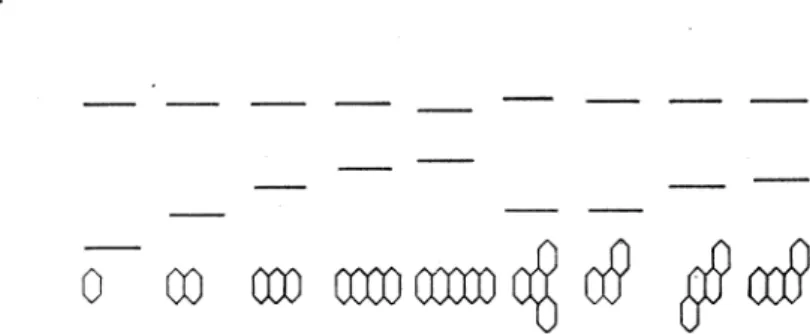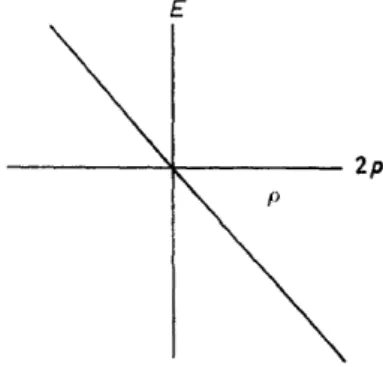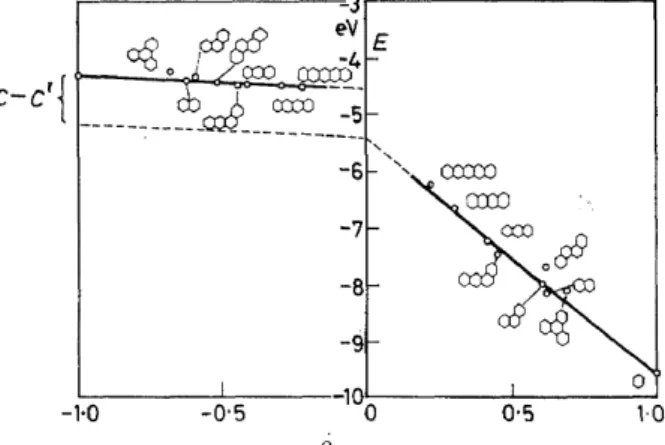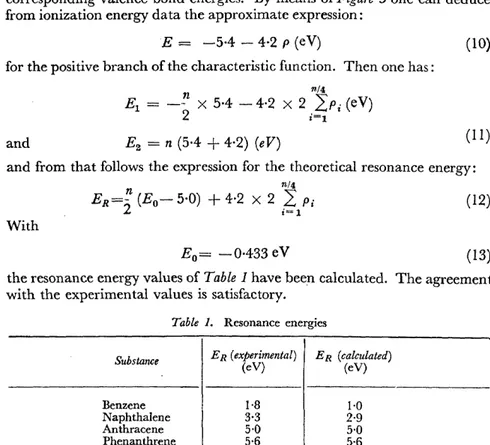NEW CONCEPTS IN THE THEORY OF 7t-ELECTRON SPECTRA
H. HARTMANN
Institut für Physikalische Chemie, Universität Frankfurt, Frankfurt-am-Main, Deutsche Bundesrepublik
Ten years ago, in 1951, I had the pleasure of presenting the first results of our work on the analysis of spectra of complex compounds1 to the meeting of European spectroscopists held at Basle in Switzerland. Since that time, we, and a whole group of scientists in different countries, have developed our original idea, and today it can be said that a new field of molecular spectro.:.
scopy has arisen, known to most of you as ligand field theory. Certainly, it would be a pleasant task to give a review of this field here. But I think that it is better to contribute a new idea or a new concept if possible, and I hope to be able to do that. My contribution today concerns the theory of spectra of molecules with 7T-electron systems. As you all know, the exactness and the generality oftheoretical results for complicated molecules are, to some extent, complementary. I am much more interested in general, qualitative concepts.
Therefore, I shall speak about the interpretation of spectra of 7T-electron systems within the framework of one-electron theories. In this field a quarter of a century ago, a strange difficulty was encountered, which till now has not been resolved. On Hückel's2 theory of 7T-electron systems, all energy values can be expressed as multiples of the resonance integral
ß.
The ß-value determined from calorimetric data is 20 kcalfmol. If one uses this value for the calculation of spectroscopic excitation energies, the resulting energies are too low by a factor of one-third. But there is another difficulty, which concerns not only the one-electron theories, but all the theories for the interpretation of 7T-electron spectra. Scheibe3 recently detected a very general regularity which till now could not be explained by existing theories. I shall take the spectra of aromatic hydrocarbons as an example for the demonstra- tion of Scheibe's rule. In Figure 1, the ground states for a group of aromaticlonization limit
0 CO
Figure 1. The ground states for various aromatic hydrocarbons shown in thei positions relative to the common ionization Iimit
I~
H.HARTMANN
hydrocarbons are shown in their relative positions with respect to the common ionization limit. Next, for each molecule, the centre of gravity of the excited singlet state 1L
6 and the first triplet state 3L
6 is given;
this should resemble the position of the first excited one-electron state on the energy sca.le. Apart from the case ofbenzene, and, to a certain degree, that of naphthalene, 1La is, in fact, the first excited singlet state of the respective molecule"'.. Now Scheibe's rule is easily formulated: the first excited one- electron states of the molecules of the group all have nearly the same distance from the ionization limit. So the first excited one-electron state becomes the first of a series of Rydberg states. The difficulty for the theory lies in the fact that the first excited one-electron state has been explained previously by theories using only atomic 2p-eigenfunctions. Also one cannot see how such a theory can account for the fact that this state is not only a "1r-state", but also the first of a series of Rydberg states. I hope to show that both difficulties mentioned above disappear on a closer analysis of the basis of HückePs theory.
A formal half of the ethylene molecule, which we may call the "con- stituent group", can be formed in the following way. We add to a carbon atom in the ground state C2s22p2 3P the energy of ""7 eV and bring it to the trigonal valence state Csp~r· Then the a-bonds are formed, and we get the a-bond energy B. The corresponding positive ion of the constituent group can be formed in an analogous way. Adding 11·2 eV to a carbon atom, we get the positive carbon ion in its ground state C+2s22p2p. Then again I"'.J 7e V are necessary5 for the excitation to the trigonal valence state C +sp;r of the positive carbon ion. Finally, the a-bonds are formed, and, in a first approximation, we should get the same a-bond energy B. Thus far, the value ofthe ionization energy of the constituent group should be nearly the same as the value of the ionization energy of the carbon atom ( 11·2 e V) ; but we have overlooked two things. When the carbon ion in the trigonal valence state is combined with its ligands to form a-bonds, the interaction between the charge situated on the carbon ion and the formally neutralligand atoms contributes_a positive amount ofenergy ofthe order ofmagnitude of 1 eV, which hitherto has been disregarded. This effect should increase the ionization energy of the constitu- ent group. But, according to approximate calculations of Hellmann6,
which can be applied here, the induction of electric moments in the formally neutralligand atoms produced by the charge ofthe carbon ion should lower the ionization energy by several eVs. So the ionization energy ofthe constitu- ent group should be much lower than 11·2 eV. These statements do not concern the free methyl radical, because this molecule in its ground state is not necessarily flat, and its ionization energy cannot be compared directly with the ionization energy ofthe formal half of an ethylene molecule.
The ionization energy of the constituent group must certainly be lower than the ionization e.riergies of all aromatic hydrocarbons. That follows from the fact that ionization of an aromatic hydrocarbon molecule means the removal of an electron from a bonding molecular electronic state. From known values7 for the ionization energies of aromatic hydrocarbons, one can see that these values converge with increasing number, n, of carbon atoms in the molecule to 5-4 eV. We take this value as the ionization energy of the constituent group. So the "atomic -2p-state", which is the starting-
16
point of Hückel's theory, lies 5·4 eV below the ionization limit (Figure 2).
Between this state and the ionization limit there lie all the higher atomic states from 3p on. The Rydberg correction for the 3p state is certain to be small, so that its distance from the ionization limit should be approximately 1·5 eV (Figure 2). According to the fact that the ionization energy of ethylene is 10·4 eV, the bonding molecular state of this molecule lies 10-4 eV below the ionization limit. From spectroscopic data, one can deduce that the antibonding state is 6·6 eV above the bonding state, and so lies 3·8 eV below the ionization limit. From Figure 2, it is easily seen that the distance between the bonding and the antibonding state of ethylene is greater than the
Ionization - - - - limit
- - 3 p
- - a
- - 2 p
- - b Figure 2. Atomic and molecular elec- tronic states in the ethylene molecule
distance ofthe "atomic
2p
state" ofthe constituent group from the ionization Iimit. Under these circumstances, it is impossible that a pure 2p theory like Hückel's can explain all characteristic features of the phenomena. I t is certainly necessary to include the higher atomic states in the calculations from the outset. This is a routine matter, and has been reported elsewhere8 • The formalism of the molecular orbital theory can easily be extended to include higher atomic eigenfunctions. In practice, there is the difficulty that the series of higher atomic states to be included should be limited in a sensible way. For qualitative purposes, the 3p state can represent all higher states. The results of the calculation can be described in the following way.For every molecule there exists the structure matrix s. The elements s i. of this matrix are equal to unity when the carbon atoms with numbers i aAdj are neighbours. All other elements ofthe matrix, including the diagonal elements, are zero. The eigenvalues ofthe structure matrix are called Hückel's numbers. For example, the Hückel numbers for benzene are: 2, 1, 1, -1,
H.HARTMANN
-1, -2; and for anthracene: 2-41, 2·00, 1·41, 1·41, 1·00, 1·00, 0·41, -0-41, -1·00, -1·00, -1·41, -1·41, -2 ·00, -2-41. The molecular electronic states can be collected into groups, which we call bands. Each band com- prises n states, one for each Hückel number. For each band there exists a so-called characteristic function:
(I) which gives the energies of the molecular electronic states of the rth band as function of the corresponding Hückel numbers of these states. The lowest band may be called the valence band. If the atomic
3p
states only are regarded additionally, the characteristic function of the valence band contains as parameters three Coulomb integrals a 2 2 , a 2 3 , a 3 3 and three resonance integralsß
2 2,ß,
2 3 ,ß
3 3 • If, in a first approximation, the Coulombintegrals are neglected compared with the resonance integrals, the characteristic function still contains the three resonance integrals as parameters. One can determine two of them as functions of the third from the data of Figure 2.This means that the parameters of the theory are adjusted to the ethylene molecule. Apart from the rule:
I
ß22I < I ß2a I < I ßaal
(2)which follows from the definition of the resonance integrals, the third para- meter can not be determined in this way. Fortunately, however, the characteristic function is not appreciably influenced by the choice of the third parameter. The typical appearance of this function is always the same, and it is represented in Figure 3. In Hückel's theory, the connection between the energies and the Hückel numbers in the same approximation is given by:
(3) This is represented in Figure 4. From Figure 3, one can see that, in the new extended theory, the energies of different bonding states (which belong to positive p~values) are different, as in Hückel's theory, and that these energies are approximately proportional to p. However, in the ·new theory, the ener- gies of the antibonding states (which belong to negative p-values) disagree
E
Figure 3. Characteristic fundion of the valence hand
18
E
---~~--- 2p
p
Figure 4. Characteristic function of the valence band in Hückel's theory
with Hückel's theory, and are all nearly equal to the energy of the "atomic
2p
state". So the energy ofthe first excited (antibonding) state should have the same value for all molecules, and that is just what Scheibe has found empirically.Since the positive branch of the characteristic function is approximately proportional to p, the ionization energies should be a linear function:
I = 5·4
+
C Pb (4)of the Hückel number pb of the last bonding molecular state. In the right- hand part of Figure 5, the ionization energies (X -1) of different hydrocar-
~---~-3.---~
eV E -4
-6 '
oxco oxo
-7 -8 -9
0
-1·0 -0·5 O·S 1·0
p
Figure 5. The empirical characteristic function determined from ionization analysis and spectral data
bons are plotted against the Hückel numbers of the last bonding states of these molecules. This part of the figure confirms the equation (4). E may be the energy of the ground configuration where all bonding states ari doubly occupied. If electron-repulsion between the ''last" two electrons is included, the energy of the singlet ground state of the molecule becomes:
El(t)
=
Ee+
C' (5)where C' is a Coulomb integral. The second singlet state 2(1) and the first triplet state 1 (a) of the molecule can, in most cases, be derived from the first excited confi.guration. If the electron-repulsion between the "last"
two electrons is included, their energies are:
E2<t> =E1+C-A and E1<3)=E1+C+A (6) where E 1 means the energy of the first excited confi.guration in the one- electron theory, Cis a second Coulomb integral, and A an exchange integral.
In the series of aromatic hydrocarbons, the difference:
(7) is remarkably constant. The quantity (C-C') would, therefore, be expected to vary only a little from molecule to molecule. From equations (5), (6) and (7), the following relation is derived:
D
H.HARTMANN E2C1
)+
El(a)- EI<1> = (Erx- Eg)
+
(C-C').2 (8)
Provided that ( C -C') is sufficiently constant, plotting the empirical quantity (-I
+
D) against the Hückel numbers of the first antibonding state should furnish the negative branch of the characteristic function apart from a vertical shift, ( C -C'). The whole of Figure 5 shows that the theory is in good agreement with the empirical data.So far, the first difficulty mentioned above has not been resolved, though the solution of this problern is rather easy. Hückel and all subsequent workers in the field of molecular orbital theory have not appreciated that they had attached the wrong theoretical energy value to the so called empiri- cal resonance energy.
A comparison of molecular orbital energy values with results of valence bond calcu.lations may make that clear. In Figure 6 are collected the valence
E1 = 6C+2·6A E2=3C+A E3 = 6C +1·5A Figure 6. The valence bond energies for the ground state of mesitylene, for the ground state of a formal isomer of mesitylene, and for mesitylene with
' localized bonds
bond energies for the ground state of mesitylene, for the ground state of a formal isomer of mesitylene with separated double bonds, and for mesitylene with localized bonds. E 1 and E 3 are different. According to Hückel, only the difference (E 1 - E 3) can be identifi.ed with the empirical resonance energy, and I am of the same opinion. Now, in Figure 7 are collected the corresponding energy values calculated with the Hückel molecular orbital theory. In this case, E3 is not defined, because the term "localized bond"
E1 = 6oe+ 8(3 E2 = 6oe+6ß
Figure 7. The energy values for the ground state ofmesitylene, for the ground state of a formal isomer of mesitylene, and for mesitylene with localized
bonds, calculated by means of the Hückel molecular orbital theory
has no analogue in the simple molecular orbital theory. In the molecular orbital theory, the difference (E1 - E2) has hitherto been identified with the
20
empirical resonance energy, and evidently this is an error. The only basis for a more realistic comparison is that, in the formalism of the. valence band theory, the difference between E 2 and E 3 for aromatic hydrocarbons is proportional to the nurober n/2 of double bonds. So we can write for the resonance energy:
(9) where E 0 is a constant, which need not necessarily be taken over from the corresponding valence bond energies. By means of Figure 5 one can deduce from ionization energy data the approximate expression:
E = -5·4- 4·2 p (eV)
for the positive branch ofthe characteristic function. Then one has:
n/4
E1
= __
nx
5·4- 4·2x
2 LPi (eV)2 i=t
and E2
=
n (5·4+
4·2) (eV)(10)
( 11) and from that follows the expression for the theoretical resonance energy:
n/4
ER=!! (E0 - 5·0)
+
4·2 X 2L
Pi (12)2 i=l
With
E0
=
-0-433 eV (13)the resonance energy values of Table 1 have been calculated. The agreement with the experimental values is satisfactory.
Table 1. Resonance energies
Substance ER (experimental) ER (calculated)
(eV) (eV)
Benzene 1·8 1·0
NaphthaJene 3·3 2·9
Anthracene 5·0 5·0
Phenanthrene 5·6 5·6
I t is tobe hoped that the theory which I have described will serve in the future as a better basis for the analysis and the understanding ofthe spectra of 7T-electron systems. For more quantitative investigations, one will have to include the explicit treatment of electron interaction as the next approxima- tion. The necessary formalism for doing this is well-known. Certainly the inclusion of higher atomic eigenfunctions into the one-electron functions, which are to be used in such calculations, will Iead to improvements of existing multi~electron theories. However, the essential point in my opinion isthat the theory can resolve the most puzzling difficulties that have so far been encountered in the elementary first approximation.
21
H.HARTMANN
References
1 F. E. Ilse . .Dissertation, Frankfurt University (1946)
F. E. Ilse and H. Hartmann. z.phys. Chem., 197,239 (1951); z. Naturforsch, 6a, 751 (1951);
H. Hartmann and H. L. Schlafer. Z· phys. Chem., 197"' 116 (1951); Z· Naturforsch., 6a, 754, 760 (1951)
2 E. Hückel. Z· Physik~ 60, 423 (1930); 70, 204 (1931); 72, 310 (1931); 76, 628 (1932);
Grundzüge der Theorie ungesättigter und aromatischer Verbindungen, Berlin ( 1938)
3 G. Scheibe and D. Brück. z. Elektrochem.,54, 403 (1950); Chem. Ber.,85, 867 (1952) G. Scheibe, I. Kern and F. Dörr. Z· Elektrochem., 63, 117 (1959)
4 H. B. K1evens and I. R. Platt. J. Chem. Phys.,21, 1565 (1953)
5 R. S. Mulliken. J. Chem. Phys., 2, 782 (1934)
6 H. Hellmann. Einführung in die Quantenchemie, Leipzig (1937)
7 F. A. Matzen. J. Chem. Phys.,26, 602 (1956)
8 H. Hartmann. Z· Naturforsch., 15a, 993 (1960)
22




